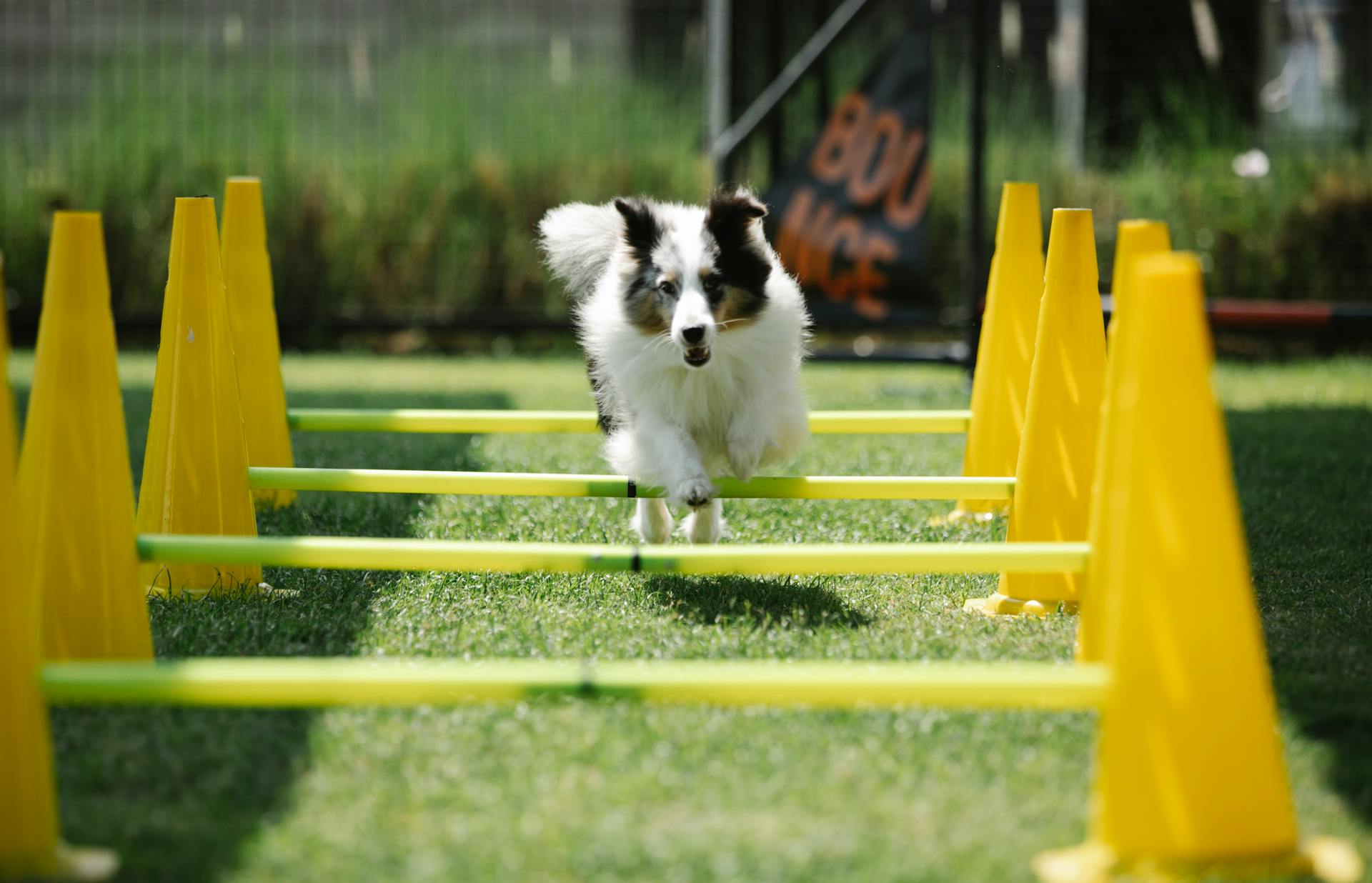
Dogs with high prey drive require activities that challenge their instincts without causing harm to themselves or others. Engaging in hunting simulations can help redirect their energy.
High-energy breeds like Border Collies and Australian Shepherds often excel at activities that mimic hunting, such as agility courses and flyball. These games provide physical exercise and mental stimulation.
Dogs with high prey drive can also benefit from scent work, which involves using their sense of smell to find hidden items. This activity can be done indoors or outdoors and is suitable for dogs of all sizes.
Providing your dog with plenty of exercise and mental stimulation can help manage their high prey drive and prevent destructive behavior.
Readers also liked: High Energy Dogs Breeds
Understanding High Prey Drive
High prey drive in dogs is a natural instinct that's deeply rooted in their genetic makeup. This behaviour is often seen in breeds that were selectively bred for hunting and working purposes, such as terriers, hounds, herding dogs, and some sporting breeds.
For more insights, see: Dog Breeds Watch Dogs
Dogs with high prey drive display intense focus, alertness, and excitement when they detect movement that triggers their hunting instincts. They might show behaviours such as stalking, fixation on small animals, intense interest in fast-moving objects, or repeated attempts to chase anything that moves quickly.
Understanding the origins of high prey drive is essential for dog owners, as it can significantly impact a dog's behaviour and interactions with its environment. Breeds such as sighthounds, like greyhounds, are skilled at chasing prey, while Labradors are known for their ability to retrieve prey animals.
Dogs with high prey drive need to be managed and channeled appropriately, as not doing so can lead to significant challenges, including potential safety risks for smaller pets and animals in the home or outside areas. Consistent training can help establish boundaries and teach the dog appropriate behaviours in different situations.
Here are some signs that your dog has a high prey drive:
- Chasing wildlife, other pets, bikes, cars, and skateboarders
- Herding people or pets
- Digging in rodent holes
- Tracking scents
- Fixating on birds
- Killing small animals
These behaviours are normal in dogs and shouldn't be punished. However, you can take steps to manage the behaviours to keep your dog and other animals safe.
Managing High Prey Drive
Managing high prey drive is crucial for dog owners, as it can significantly impact a dog's behavior and interactions with its environment. High prey drive is deeply rooted in a dog's genetic makeup, particularly in breeds selectively bred for hunting purposes.
Dogs with high prey drive often display intense focus, alertness, and excitement when they detect movement that triggers their hunting instincts. They might show behaviors such as stalking, fixation on small animals, intense interest in fast-moving objects, or repeated attempts to chase anything that moves quickly.
To manage high prey drive, training plays an important role. While it's challenging to eliminate this instinct completely, training can help control and redirect the behavior. Consistent training can help establish boundaries and teach the dog appropriate behaviors in different situations.
Physical exercise is also essential in managing high prey drive in dogs. Providing ample opportunities for structured, high-energy activities such as fetch, agility training, or scent work can help satisfy the dog's need for stimulation and prevent the build-up of excess energy that might lead to impulsive chasing behaviors.
Broaden your view: Does Neutering Help Dog Aggression
Controlling the dog's environment is vital. Using training leads or secure enclosures can prevent situations where the dog might be tempted to chase or potentially harm other animals. Supervision is also crucial, especially in areas where wildlife or family pets are present, as a dog with a strong prey drive might act on instinct without warning.
It's also essential to focus your dog's attention and distract them before they see the object of their desire. Call your dog's name or use a squeaky toy to get their attention, and move backwards quickly to play a targeting game or give them small treats.
Positive training classes can teach your dog alternative behaviors and impulse control. In class, you'll learn Watch Me, Leave It, targeting, and coming when called. Practice these skills a lot first without distractions, then with increasing distractions, so they'll work when you need them.
For more insights, see: No Treat Dog Training
Training Your Dog's Attention
Training your dog's attention is crucial to managing their prey drive. You can distract your dog before they see the squirrel by calling their name or using a squeaky toy.
Chasing is a self-reinforcing behavior, and it's fun for your dog, but it can be difficult to get them back once they're focused on what they're chasing. Move backwards quickly to get your dog's attention.
Change your pace on walks to keep your dog guessing. Try a fast walk, a slow saunter, and every pace in between. Rotate in different directions, take detours, and make sudden turns to keep your dog engaged.
Positive training classes can teach your dog alternative behaviors and impulse control. You can learn Watch Me, Leave It, targeting, and coming when called, all of which can help with prey drive.
Redirection means shifting your dog's attention away from the prey and onto you. It's much easier to do this before your dog fixates on the prey, or very soon after.
Remain calm throughout your dog's prey drive training. If you get too excited, your dog will pick up on the energy and it will slow down their progress.
You can try to satisfy your dog's prey drive through other acceptable activities, such as sports like Treibball or Disc Dog, or play at home throwing a Frisbee or ball.
Readers also liked: Tail Chasing
Staying Calm and Focused
Staying calm and focused is crucial when working with dogs that have high prey drive. This means remaining calm throughout training sessions, as shouting or getting too excited can lead to over-excitement and hyperactivity in your dog.
You should focus your dog's attention by distracting them before they see the object of their desire, such as a squirrel. Call your dog's name or use a squeaky toy to get their attention, and then move backwards quickly.
It's essential to stay calm in situations where your dog wants to chase an animal or object. Yelling or reprimanding your dog can encourage them to go after it. Instead, use positive reinforcement like praise and treats when they obey you instead of their prey drive.
To keep your dog under control, consider training them in a class that teaches alternative behaviors and impulse control. In these classes, you can learn commands like "watch me", "leave it", and "targeting" to help manage your dog's prey drive.
Broaden your view: When Do Labradors Calm down
Activities and Exercises
Engage your dog's high prey drive with activities that mimic hunting behavior, such as playing hide-and-seek with toys.
Treat-dispensing toys and puzzle toys are great options to challenge your dog's problem-solving skills and satisfy their hunting instinct.
Flyball is a high-energy sport that allows your dog to engage in predatory behavior, making it an excellent outlet for dogs with high prey drive.
Agility training is another great option, providing a physically and mentally stimulating environment for your dog to burn off energy and exercise their hunting instincts.
Playing a game of fetch each day can be as simple yet effective as taking time to engage your dog's natural instinct to hunt and chase.
K9 nose work is a fun and engaging activity that works with your dog's natural instinct to hunt and track scents, providing mental stimulation and exercise.
If this caught your attention, see: Dog Food for High Energy Dogs
Sources
- https://yourdogsfriend.org/help/chasing/
- https://www.pethonesty.com/blogs/blog/understanding-prey-drive-in-dogs
- https://www.b2bcaninebehaviourist.co.uk/dog-behaviour/high-prey-drive-in-dogs
- https://www.barkandwhiskers.com/2023-12-08-prey-drive-in-dogs/
- https://k9ti.org/blog/get-your-dogs-prey-drive-under-control/
Featured Images: pexels.com


